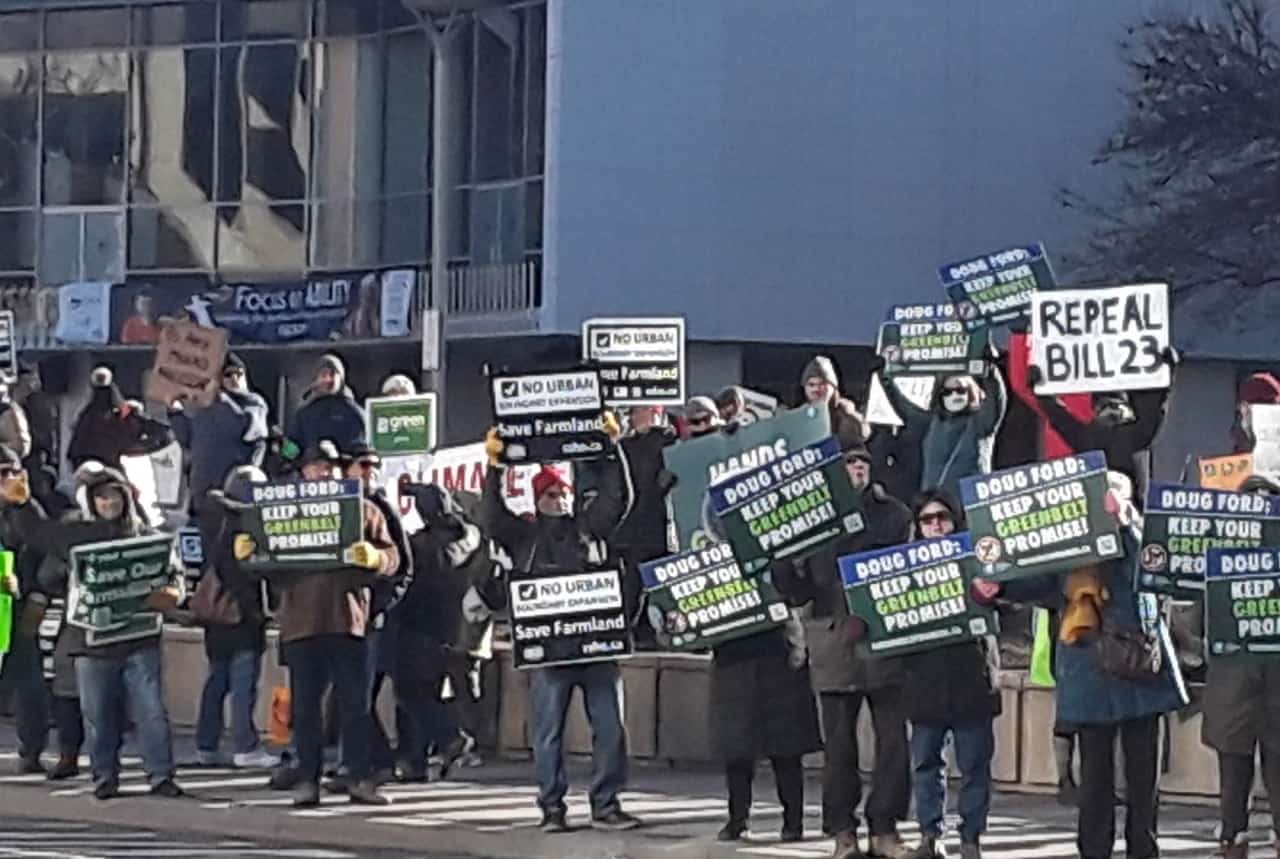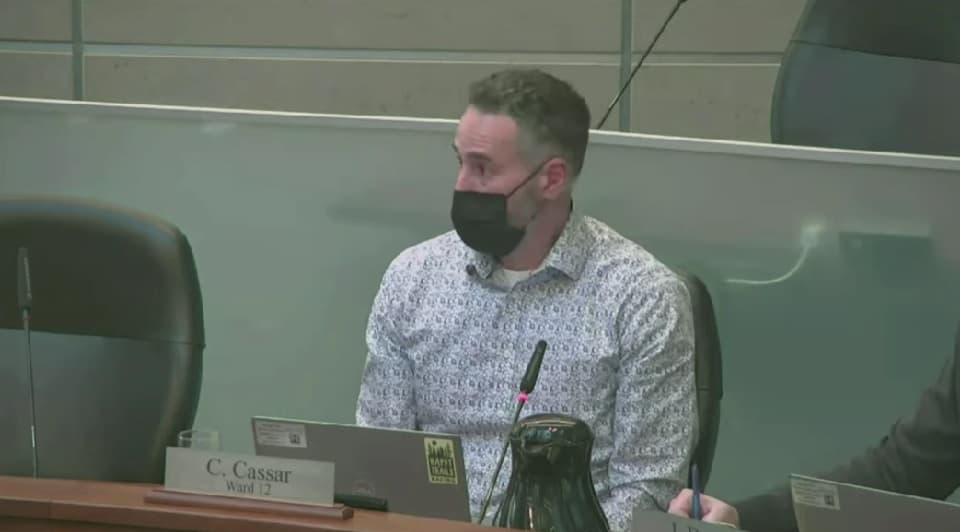‘Unnecessary’; Ontario development plans for Hamilton panned unanimously
Published February 1, 2023 at 6:43 pm

Hamilton city council, roused by Ward 8 Coun. John-Paul Danko, have drawn their symbolic line in the fertile soil that the government of Premier Doug Ford contends is needed for housing during the climate crisis.
By a unanimous 15-0 vote, Mayor Andrea Horwath and all councillors present at a general issues committee (GIC) meeting today (Feb. 1) backed the West/Central Mountain representative’s motion that provincial development edicts, while irreversible by local councils, are “unnecessary” in Hamilton. The motion speaks to the 2,200 acres of ‘whitebelt’ agricultural, rural, and natural heritage lands that were opened up when the province nixed Hamilton’s urban boundary freeze in November, as well as 795 hectares in the city that will be removed from the Greenbelt (the overall plan swaps in more land than it takes out provincewide).
It does not address Bill 23, the More Homes, Built Faster Act.
“People still want single-family homes and we as a council have to be cognizant of that,” Danko said. “But that does not make up for the ministry unilaterally overriding the democratic local decision-making authority of the City of Hamilton. It is pretty clear that even if we needed additional land to develop on, fundamentally, that time is not now, and that time might not be before us in the next 10 years.
“I am hopeful that this motion can set a foundation for this term of council for what our approach is going to be going forward. We cannot change the minister’s decision. We are legally obligated to follow the minister’s decision. But we can set our priorities as a council and I’m hoping, unanimously, to set our priorities and our goals.”
The province, under Municipal Affairs and Housing Minister Steve Clark in the Premier Doug Ford-led PC Party government, has assigned Hamilton to add a total of 52,400 housing units by 2031. The motion from Danko states, “Hamilton already has lands designated and in many cases approved to accommodate approximately 37,000 units of new development, which is approximately 10.5 years of housing supply, not including abundant opportunities for infill and intensification.”
The previous council spent hundreds of hours in 2021 hearing public delegations from environmental and social justice groups, and representatives of the building and development industries, before voting to leave the urban boundary as-is. That was added to the city’s official plan last spring; it was nixed by the Environmental Registry of Ontario last Nov. 4.
The Greenbelt land swap, which has led to an Ontario integrity commissioner investigation, became public knowledge around that time. Clark is now the subject of an Ontario integrity commissioner investigation that was demanded by Ontario New Democratic Party Leader Marit Stiles.
“I was aghast and appalled that the Ford government included Greenbelt lands in their plans,” Ward 6 Coun. Tom Jackson said at the GIC meeting today.
“It’s no surprise that the Ford government overturned the UBE (urban boundary expansion) decision,” Jackson added. “If they had stuck to that, it might have been acceptable.
“But to include the Greenbelt? Unacceptable.”
Horwath: ‘Appropriate boundary’
Mayor Horwath emphasized that the stance on the urban boundary instills urgency for Hamilton to increase its housing stock. The previous council made moves to encourage infill density. (Last Friday, councillors in Victoria, B.C., made one of the most radical moves to enhance the “missing middle,” voting to allow up to six units on every plot of land zoned for a single-family dwelling. Hamilton allows up to four.)
“There is a respect factor in terms of local decision-making,” Horwath said. “We need to get affordable housing built, purpose-built housing, continuum, missing middle housing, so young adults can have a hope they can one day be able to afford their own home. We have an obligation to get those things done within what the City of Hamilton council has decided would be the appropriate boundary.”
Several rallies, with many attendees displaying ‘Save The Greenbelt’ signs, were held in Hamilton over the course of November and December, with local politicians in attendance. Ward 12 Coun. Craig Cassar said the ramifications of what the province does extends past the loss of farmland.
“Hamiltonians have been asking us to speak up and to stand up against the direction that the province has imposed on us — and that is the step we are taking today,” said Cassar, who cofounded the Save Our Streams Hamilton wetlands protection coalition with Ward 13 Coun. Alex Wilson before being elected in October.
“I just want to make a brief comment on how inadvisable and reckless the province’s decision is,” Cassar added. “I think people who engaged with the Stop Sprawl (HamOnt) campaign that led up to the boundary decision (in 2021) knew farmland would be lost, which is absolutely true — and critical.. What people might not understand is how the quality of life — for all residents, all demographics, and all income levels — is affected when you continue to add sprawl with single-family homes.
“I’ve read copious amounts of advice on the topic over the past year, and none of the advice suggests we should have a senior level of government continue to put forth a policy that continues to add sprawl.”

Ward 10 Coun. Jeff Beattie said he had thought of voting against the motion. But he said the province’s requests of the city are unrealistic.
“We asked staff how we would be able to operationalize this, and there were a lot of shrugging shoulders,” he said. “I’ve never seen so many shrugging shoulders. But we have a plan that can be operationalized.”
Ward 9 Coun. Brad Clark also wrote a motion looking at the property tax impact from provincial changes. Clark was absent from the meeting, so his motion was put over to the next GIC meeting.
In the fall, fall, council requested that Premier Ford’s Hamilton-area PC Party of Ontario MPPs, Tourism, Culture and Sport Minister Neil Lumsden (Hamilton East—Stoney Creek) and Donna Skelly (Flamborough—Glanbrook), appear at a meeting to discuss the plan. Neither Lumsden, a former sports executive, nor Skelly, a former broadcast journalist who was once the Ward 7 councillor, have been available.
However, Housing Minister Steve Clark did send three letters of correspondence about the changes. His spokesperson also supplied inTheHammer with a statement that indicated the province has some willingness to ensure cities are “kept whole” after pending changes to development fees that they collect.
Ecojustice, an environmental group, is taking the Ford government to court over the urban boundary ruling. Councillors on the planning committee voted 10-2 on Tuesday against instructing the city to apply for intervenor status in that case at that stage.
The Mississaugas of the Credit First Nation are considering legal action to stop the Ford government’s proposed changes to Greenbelt land. The geographical footprint of Hamilton is on the Mississaugas’ traditional territory.
insauga's Editorial Standards and Policies advertising





